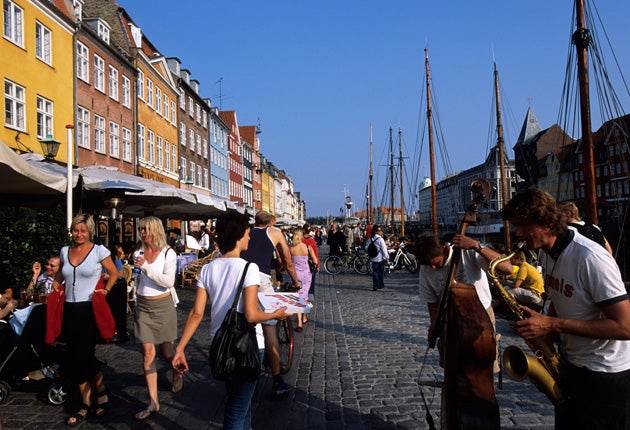Trail of the Unexpected: Musical Copenhagen
Copenhagen should be on the map for everyone with a thirst for jazz, says Thomas E Kennedy

Your support helps us to tell the story
This election is still a dead heat, according to most polls. In a fight with such wafer-thin margins, we need reporters on the ground talking to the people Trump and Harris are courting. Your support allows us to keep sending journalists to the story.
The Independent is trusted by 27 million Americans from across the entire political spectrum every month. Unlike many other quality news outlets, we choose not to lock you out of our reporting and analysis with paywalls. But quality journalism must still be paid for.
Help us keep bring these critical stories to light. Your support makes all the difference.
Chicago, Memphis ... Copenhagen? Yes, name just about any jazz legend, and he or she has a connection with the Danish capital. Some – such as Stan Getz, Dexter Gordon, Ben Webster – lived here for years; others – like the great bassist Niels Henning Orsted Pedersen – were born here and began playing as teenagers with the great jazzmen passing through.
And most of them played in the Jazz Club Montmartre, which opened in 1959, featuring one of the greatest tenor sax players of all time, Stan Getz, on his 32nd birthday. The Montmartre club has just reopened after a 15-year hiatus, and I am on my way to witness the tribute to Getz planned for this evening.
I come in from the east side of the city, quite another Copenhagen to the bustling touristic centre of Tivoli Gardens and Town Hall Square and the kilometre-long pedestrian shopping street, Stroget. On the east side, the "street lakes" begin – a trio of long, narrow artificial ponds. I stroll the bank of Sortedamso (Black Dam Lake) beneath the budding chestnuts, swans gliding past like white question marks.
To the left, I cut across the Botanical Gardens, the largest collection of living plants in Denmark to Norreport (the North Gate – from the time the city was a walled fortification). Here is one of my favourite squares in the city, Kultorvet (The Coal Square).
From 1 April, the Coal Square is edged with outdoor cafés and peopled with buskers who entertain café patrons by adding music to their stolen moments of sunshine and a latte or draught beer. You can eat here, too, Danish fare, and I often do, especially at Det Hvide Lam (The White Lamb, established 1807). Here you can enjoy "unspecified sandwiches": fish or meat on a slice of dark rye, well-garnished – you take what you get. They are delicious with a cold Tuborg or any of two dozen other beers, and very cheap. A late lunch here satisfies my hunger, and I don't have to pay eight times as much for the sophisticated three-courses with wines at Montmartre. The White Lamb also offers live music every night, so-called "Happy Jazz", with free entry, and often as not people get to dancing, too.
From the Coal Square, were I to go right, I would in a trice be at Copenhagen Jazz House ( jazzhouse.dk) – where, in fact, I was the evening before, for two hours, in the thrall of Klüvers 17-piece Big Band, blazing with the music of the young American composer, Maria Schneider. The audience was 60-strong, and the solos were sublime, enhanced by five woodwinds, four trombones, four trumpets, drums, piano, guitar and bass. The soprano sax solo on the love theme from Spartacus alone was worth the price of admission.
But that is not my destination tonight, so I hook left along Gothersgade, past the Café Jazz Cup (live jazz on Friday and Saturday afternoons). On my left are the fairytale turrets of Rosenborg Castle and the expansive public gardens of Kongens Have (The King's Garden), where many free concerts are staged during the week of Copenhagen's annual jazz festival ( jazzfestival.dk). Then I head down Gothersgade to Montmartre.
Tonight the American-Swiss alto sax player, George Robert, joins three outstanding Danish musicians; in Robert's words, the experience feels "like flying the new Airbus A380 – but with your eyes closed!" The new Montmartre ( jazzhusmontmartre.dk) is a classic club: tiny, so intimate you can hear the valves of the sax squeak. I show up alone, but soon am chummy with the other four at my table – two artists and two musicians.
The artist couple (she with a colourful tattoo on her shapely shoulder, he with a cool, grey pony tail) recommend good places for gypsy jazz. Amid the Getz tributes ("On Blue Dolphin Street", "Just Friends", "Grand Amor", a rousingly urgent version of "Black Orpheus"), there is also a piece of instant history – Robert's first public performance of a piece entitled "Montmartre", which he finished composing that morning.
As there are so many places to enjoy jazz in Copenhagen, let me mention one more, a walk on the slightly wilder side. Cross the smaller of two bridges to Amager and the so-called free state, Christiania (christiania.org) and the Christiania Jazz Klub ( christiania-jazzklub.com). This is a dark, smoky room on a muddy, rutted street inside the squatters' enclave. It has charmingly mismatched furniture, a friendly, cosy atmosphere and often top-notch jazz. You might find yourself on a truly unexpected trail – dancing with a stranger to the music of eight Swedish beauties playing big-band bossa nova.
As the Danish national anthem insists, "This is a lovely land ..."
Thomas E Kennedy is the author of The Copenhagen Quartet, four novels about the seasons and souls of the Danish capital. The first – 'In the Company of Angels' – was published by Bloomsbury this year; the second, 'Falling Sideways', will appear in 2011.
Join our commenting forum
Join thought-provoking conversations, follow other Independent readers and see their replies
Comments